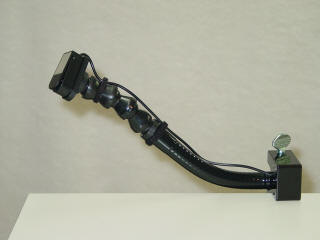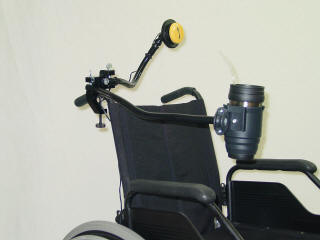Mealtime Partners, Inc.
Specializing in Assistive Dining and Drinking Equipment
April 2013 Independent Eating and Drinking Newsletter

|
April Topics:
|
||
|
Mealtime Partners Home Page Send a Comment or Suggestion |
|||
| Subscribe to Newsletters |
Chin Positioning During Swallowing
For several decades it has been known that proper posture and body alignment, including a chin-tuck being produced by correct alignment of the head, are an essential part of safe eating and drinking for those who have disabilities that impact their ability to eat. Appropriate body position can minimize the risk of aspiration and is essential for patients with a diagnosis of dysphagia to reduce their likelihood of inhaling materials into the lungs. There is no perfect position for eating and/or drinking that applies to everyone and each person’s individual needs must be addressed to establish the best position for them. However, there are some general rules to maximize safety while eating that apply for the majority of people who have dysphagia and/or who are fed.
The first steps towards a safe mealtime should be taken well before a meal. The person who is going to eat should be well rested before starting to eat. They should also have time to become calm and not be over stimulated. Tiredness and over stimulation can both lead to swallowing difficulties. Additionally, in preparation for mealtime, they should be wearing their glasses (that should be clean), and their hearing-aid and false teeth (if any of these items are needed). Being able to see, hear and chew properly greatly enhances the safety and enjoyment of mealtimes and yet these items are frequently overlooked, especially for people who are fed.
A chin-tuck is also referred to as a chin-down position. There are three commonly used techniques for a chin-tuck. The first involves head flexion that bends the cervical spine at its highest point C1 through C2. Head flexion moves the chin against the neck. The eyes will be directed downward when this position is assumed and the person will have to raise their eyes to see their mealtime partner. This type of chin-tuck is used to reduce residual particles of food pocketing in the epiglottic valleculae. The epiglottic valleculae are two depressions situated between the base of the tongue and the epiglottis, one on each side of the median glosso-epiglottic ligament. (Diverticulum of the epiglottic valleculae: Report of two cases) Their normal function is to collect saliva prior to a swallow, and for people without swallowing difficulties, they do not collect food particles during a bolus being swallowed.
The second type of chin-tuck is created using neck flexion and is instigated by flexing the cervical spine at C4 through C6. This position is helpful for those who have poor initiation of a swallow. A compound flexion combines head and neck flexion and is helpful to avoid particles pocketing in the epiglottic valleculae and to improve swallow initiation. A compound flexion, or a variation of it, is typically what most people refer to as a chin tuck.
In addition to the chin tuck being used to improve the safety of swallowing, for those who have paralysis of part of the pharynx, due to conditions such as bulbar paralysis or stroke, head rotation is helpful in combination with a chin-tuck. The head is rotated to the weak or paralyzed side and this position expands the stronger side guiding the bolus to the healthy side of the throat.
In some cases of using a chin-tuck to help with swallowing food, the food can be put into the mouth and chewed prior to assuming a chin-tuck in anticipation of swallowing. The head is upright to receive a bite of food, the food is chewed and rotated in the mouth to form a bolus, prior to swallowing, the chin is dropped into a chin-tuck and the swallow is then initiated. This process is helpful for those who have difficulty with lip closure and keeping food in their mouth while they are chewing.
Regardless of the strategies that may be employed to facilitate the safest swallow possible, the texture of the food and liquid being consumed contributes greatly to how easy it is to swallow. Detailed information about food texture and thickening liquid is available in the April 2010 Newsletter if more information on this subject is of interest. Other Newsletters articles on closely related subjects can be found at the following Newsletter links: June 2009: Promoting a Chin Tuck for Safer Eating; July 2009: Positioning for Eating; March 2010: Good Buttocks Positioning Promotes Safe Eating; June 2011: Positioning for Eating Revisited; September 2012: The Importance of Seating and Positioning On Eating And Drinking.
|
Mounting and Positioning
Products Most assistive technology (AT) access is dependent upon its mounting and positioning and the mounting and positioning of adaptive switches to control the AT. Mealtime Partners mounting systems provide a quick and easy way to mount and position adaptive switches and small electronic devices. Our mounting Systems include a Clamp and Flex Arm. Adding the desired Adaptive Switch on a Switch Mounting Plate appropriate for the adaptive switch, prepares the Mounting System for mounting on the selected item. Once attached to a wheelchair, bed rail or table, the Mounting System is easy to adjust, with no tools. Click on the following link for more information about our variety of available mounting systems: Mounting Products. To discuss your specific needs please email us, or call us at 800-996-8607. |
|
 |
 |
| Micro Light Adaptive Switch Attached to a Table | Double Mounting System Using One Clamp - A Front Mounted Drinking System with Jelly Bean Adaptive Switch (positioned for head control). |
| All Mealtime Partners Mounting Systems are available with 6", 12", 18", 24", or 30-inch Flex Arms to provide clamping to wheelchairs, bed rails, tables, or any other stable platform in a variety of locations. | |
Positioning When Eating In Bed
The majority of individuals who have eating and swallowing difficulties, and those who are fed, sit in a chair to eat. It is desirable that a person, who spends most of their time in bed, be moved from their bed to a chair for meals whenever possible. It not only puts the person’s body in a well aligned position which makes eating and swallowing safer but it also allows them a change of environment for mealtimes. However, for those who must remain in bed during their meals, special consideration must be taken to position them appropriately for eating. It should also be noted that extra attention should be given to making sure that they are alert during the whole meal. It is easy to become sleepy if you are reclining in a comfortable position.
Positioning for eating in bed is similar to that used when in a chair; however, the bed does not allow for the same level of weight bearing and leg positioning. To start, the bed head should be fully raised, if possible, or a stack of pillows put behind the person’s back to position them in an upright position. Their back should be as vertical as possible. If an electric bed is being used, in addition to fully raising the bed head, the knees should be supported by the bed at an angle of approximately 45 degree at the knees. If a standard bed is being used, a pillow can be placed under the knees. This makes sitting up more comfortable and it is easier to maintain an upright trunk. To understand why bending the knees is important for someone who is sitting up in bed, sit on the floor with your body vertical with your legs out straight in front of you, and you will soon find that your leg muscles become tired and uncomfortable due to the stress of the position being maintained.
Lateral stability is also important during meals and if the person who is in bed is inclined to slide to the right or left when their trunk is in an upright position, additional pillows should be used to provide lateral stability. For anyone who cannot maintain a position of at least 60 degrees, special evaluation and instruction from a speech pathologist should be sought to provide a safe eating and drinking experience.
In some environments, care providers attempt to stimulate an individual to stay awake during a meal by positioning them with their legs hanging off of the side of the bed. If the bed head is fully raised, the person can lean slightly to their side and gain stability from the bed head. Many of the hospital beds being used today allow the height of the bed from the ground to be adjusted. If this feature is available, the bed should be lowered to allow the person’s feet to rest firmly on the floor. If this feature is not available, a foot stool should be used to provide foot support for the individual so that their legs do not dangle in mid-air. If the feet are allowed to dangle, the person will be unable to stabilize their body and head, and thus increase the risk of choking or aspiration. Yet, it is better for the person to sit in a chair to eat rather than eating sitting on the side of a bed because the chair back and arms can afford them better support and the chair height allows them to reach the floor with their feet. Therefore, if they are able to sit on the edge of the bed, they should be encouraged to sit in a chair.
Regardless of whether someone is eating in bed or in a chair it should be remembered that body alignment is an essential part of safe eating and provides the foundation for the oral structure to function at its best.
| Did You Know? Did you know that according to the Centers for Disease-Control and Prevention (CDC) more than 40% of American parents introduce solid foods to their infants before they are 4 months old. The American Academy of Pediatrics current recommendation for the introduction of solid foods to infants is between 4 and 6 months of age and suggests that earlier introduction can cause health risks. At about 4 to 6 months of age babies typically weigh about 13 pounds, can hold their head up, and open their mouth when they see food. Reasons given by parents for early introduction of solids include, “it will help baby sleep through the night”, “baby seems hungry”, “my baby is old enough”, and, “a doctor or healthcare professional said my baby should begin eating solid foods”. The American Academy of Pediatrics advocates better dissemination of the recommendations of solid food introduction. For more information on this subject, refer to the following article: Prevalence and Reasons for Introducing Infants Early to Solid Foods: Variations by Milk Feeding Type. |
Mealtime Partners Website Navigation:
Home |
Dining | Drinking | Videos | All Products | Warranty | Ordering | Calendar | FAQ | Newsletters | Contact
Please send comments and suggestions to newsletters@mealtimepartners.com
Copyright © Mealtime Partners, Inc. 2013
All rights reserved.